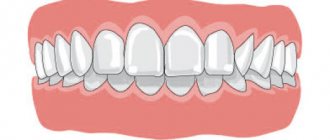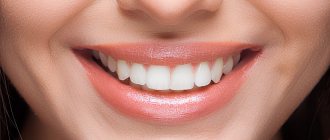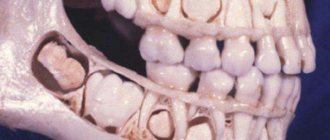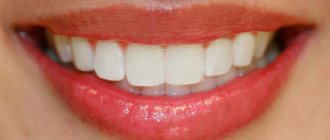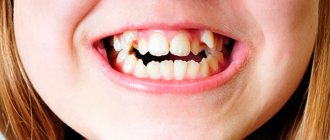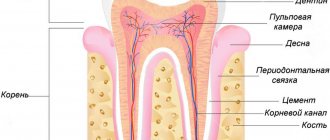Kinds
The concept of incisal disocclusion includes several causes of bite defects:
– lack of contact between the incisors due to abrasion of the enamel, changes in the angle of the tooth (sagittal disocclusion);
– contact of the incisal antagonists of both jaws with cutting edges (direct occlusion);
– advancement of the lower incisors forward while maintaining frontal contact of the lower and upper dentition (reverse occlusion);
– forward displacement of the mandibular incisors does not allow close contact with antagonists (reverse disocclusion);
– displacement of the upper incisors forward, lack of contact with the incisors of the lower jaw (vertical disocclusion);
– more than a third, overlap of incisors with antagonists (deep occlusion);
– the above defect, but with an open gap (deep disocclusion).
Edentia of the incisors due to trauma is called false incisor disocclusion.
Sagittal bite
Sagittal malocclusions are often combined with transverse ones. They are characterized by displacement of the jaws in relation to each other. This may be an overdeveloped lower jaw and an underdeveloped upper jaw and vice versa. Such pathologies are divided into mesial and prognathic.
In the first case, a noticeable protrusion of the upper jaw can be observed. The lower one is noticeably underdeveloped, which causes significant deformation of the face in the form of a sloping chin.
In the second case, the lower jaw is noticeably protruded, which causes a significant disproportion.
Such anomalies arise due to a different number of teeth in the jaws, pathology of the development of the alveolar processes, or pathologies of another similar type.
With such defects, the patient experiences difficulty in eating and there is blurred speech. Due to the incorrect position of the jaws, a constantly tense facial expression occurs.
The defect is eliminated in childhood (up to 11 years) with the help of modern technologies, in adults, especially in advanced cases, through surgical intervention.
Causes
The root causes of incisor malocclusion are the following factors:
- heredity, including chromosomal mutations;
- increase in size of the tongue (macroglossia);
- short frenulum of the tongue, lips;
- habits that prevent the correct formation of occlusion (thumb sucking, lip biting, etc.);
- breathing through the mouth due to rhinitis, adenoids and other ENT diseases;
- incorrect position of the tongue in the oral cavity;
- advanced caries of incisors;
- hypovitaminosis, metabolic disorders (including mineral), osteomyelitis, rickets, etc.;
- weakened immunity.
Anomalies of the dentition in the transversal plane
Abnormal forms of dentition in the transversal plane are distinguished by the following types (Fig. 100): 1) V - shaped, when the dentition is narrowed in the lateral sections, rotation of the central and sometimes lateral incisors around the longitudinal axis and a protruding anterior section; 2) trapezoidal, when the dentition in the lateral sections is narrowed, and the anterior one is flattened; 3) a generally narrowed dentition, when both the front and lateral teeth are located closer to the median plane than should be normal; 4) saddle shape, when the narrowing is most pronounced in the area of the second premolar and first molar; 5) asymmetrical shape, when the location of the lateral teeth to the median plane of one side and the other is different, 6) anomalies of the dentition in the presence of several supernumerary teeth (Fig. 68).
Narrowed dentition. Narrowed dentition is characterized by a change in their shape due to a decrease in the distance between the median plane and the teeth located laterally from it.
The narrowing of the upper dentition is determined in relation to the mid-sagittal suture, the lower - in relation to the median plane of the face and jaw.
The main etiological factors for the narrowing of the dentition, alveolar arch and apical base are:
1) difficulty breathing through the nose, predominant breathing through the mouth;
2) sucking of a thumb, several fingers or foreign objects;
3) dysfunction of swallowing and speech;
4) parafunctions of facial and masticatory muscles and muscles of the tongue.
The narrowing of the dentition and the lack of space for the front teeth can be explained by the weak pressure on the teeth of the sedentary tongue with its short frenulum and the prevailing action of the muscles of the lips and cheeks.
Sluggish chewing or chewing food on one side does not have a stimulating effect on the growth of the jaw bones and is one of the etiological factors in the narrowing of the dentition. The narrowed dentition, in turn, complicates the lateral chewing movements of the lower jaw and a “vicious circle” is formed, aggravating the anomaly in the development and formation of both the dentition and bite.
Premature loss of primary teeth, especially molars, significantly reduces chewing pressure, which is one of the main factors stimulating the physiological and proportional development of the jaw bones, which also causes their narrowing.
General diseases of the body - rickets, dyspepsia, infectious and other diseases that affect metabolism, weaken the body and can cause narrowing of the dentition.
Narrowing of the dentition can often be a symptom of almost all malocclusions. It is customary to distinguish between narrowing of the dental, alveolar and basal arches, which is revealed on control and diagnostic models of the jaws.
The narrowing of the dentition can be unilateral or bilateral, symmetrical or asymmetrical, on one or both jaws, without a violation of the closure of the dentition and with a violation. There are narrowing of the dentition with protrusion of the front teeth without three between them, with protrusion of the front teeth and their crowded position, with protrusion of the front teeth and the presence of a diastema and three between them. Of all the above options, the most commonly observed is a crowded position of the front teeth with rotation of some teeth around the longitudinal axis, partial or complete retention of individual teeth.
The diagnosis is established on the basis of clinical and x-ray examination, as well as the study of control and diagnostic models of the jaws. The width of the dentition in the area of premolars and molars is determined by the Pon method with correction according to Linder-Hart, the Snagina method and the width of the apical base (according to Howes). Comparison of the obtained data with the individual norm allows us to determine the severity of the dentition and choose a rational method of treatment.
In this case, the following is taken into account: 1) closure of the lateral teeth (according to Angle’s 1st, 2nd and 3rd class); 2) narrowing of the dental arch, alveolar, basal; 3) the position of the lateral teeth, i.e. whether the crowded position of the front teeth is a consequence of underdevelopment of the jaw base or other reasons; 4) whether the active period of jaw growth has ended; 5) is it possible to eliminate the anomaly using the orthodontic method or is preliminary compactosteotomy required (surgical-orthodontic method), or only the surgical method.
Treatment consists of expanding the dentition and their apical base, determining possible options for installing individual teeth in the correct position, determining orthodontic indications for removing less functionally and aesthetically valuable teeth to create space in the dentition or determining the scope of other surgical interventions (lip frenuloplasty or tongue, compactosteotomy, etc.).
Expansion of the dentition is achieved using various designs of removable and non-removable orthodontic appliances.
Removable plate expanding orthodontic devices. One of the first orthodontic devices for expanding the dentition was proposed in 1882. Coffin - a plate device with a wire spring located in the center of the base and a sagittal cut. In 1886, Kingslejy installed a screw in the base of the orthodontic apparatus. AND I. Schwartz improved the expansion plates by adding arrow-shaped clasps, retraction arches, various springs and devices for moving teeth. Kalvelis D.A. modified the Coffin expansion spring.
More often, a removable plate apparatus with a screw is used to uniformly expand the dentition, in the base of which an expanding screw is placed (Fig. 38, a).
In permanent dentition, skeletonized (large and small sizes) screws with a closed body are used for expansive opening of the median palatal suture (Fig. 38, b).
The greatest narrowing of the dentition is usually observed in the area of the premolars, therefore, when making a sagittal cut of the base of the lamellar apparatus, the screw is installed between the premolars. The distance between the model and the screw should be 0.5 - 0.7 mm. The base cut is oriented towards the position of the central incisors, the base of the frenulum of the tongue and the place of attachment of the frenulum of the lips. A plate apparatus with a vestibular arch and an expansion screw is used for simultaneous expansion and shortening of the dentition.
Asymmetric expansion of the dentition is achieved using plate devices with a screw and shaped sectoral cuts. In the area of lateral teeth subject to vestibular movement, the dentition is separated.
For this purpose, occlusal overlays are made on the opposite side on the lateral teeth with imprints of the chewing surface of the lower teeth. For uneven expansion of the upper dentition, larger in the anterior section and smaller in the lateral sections, special screws are used. When they expand, both halves of the base diverge fan-shaped, which is achieved using a screw with a limiting hinge located in the distal part of the plate for the upper jaw; in addition, the uneven expansion of the upper dentition is achieved by a plate orthodontic apparatus with a single or double Coffin spring or with a clasp spring, and also with a screw and a sectoral cut of the base (Fig. 101).
The design of the expanding plate apparatus for the lower jaw with a significant narrowing of the dentition and lingual inclination of the lateral teeth has some features. The lower edges of the base of the device must be thickened, since during fitting it is necessary to cut down the plastic from the inner surface.
In order to better fix the plate apparatus and prevent it from sliding towards the bottom of the mouth, wire occlusal pads are recommended for the lateral teeth. The screw should be loosened weekly by ¼ - ½ turn (1 - 2 movements). Instead of a screw, you can use a Cofin spring - single or double - to expand the dentition.
A plate with two Coffin springs serves to uniformly expand the upper dentition. The springs are bent from orthodontic wire with a diameter of 0.6 - 0.8 mm, the ends are given a zigzag shape to ensure their reliable fixation in the plastic base. When the finished device is inserted into the oral cavity, the springs are compressed. They tend to straighten and transfer pressure to the teeth through the base of the device. The springs are activated by extension.
The active element of the expanding plate apparatus for the lower jaw is an orthodontic screw or spring with additional semicircular bends. Standard Koller springs with a W-shaped loop with a width of 30-35 mm are also used. During manufacturing, the spring clasp is not covered with plastic; it is located under the lower edge of the base, 0.5 mm away from it.
To expand the dentition, in addition to mechanically removable and functional orthodontic appliances and devices, non-removable ones are also used.
Of the non-removable devices for expanding the dentition, the Ainsworth apparatus, the Simon beam apparatus, the Angle spring apparatus, the Begg technique, the Mershon, Herbst lingual arch, with auxiliary spring ends are used. Nord, Derichsweiler, Brun devices for accelerated opening of the median palatal suture, Levkovich kappa device with removable expansion springs, etc.
The Mershon lingual arch is fixed using special locks soldered on the palatal surface of crowns or rings on the first permanent molars. It expands the dentition in the area of molars and premolars.
The V-shaped Herbst lingual arch is fixed to the oral surface of the crowns of the first molars and is capable of expanding the dentition in the area of molars, premolars and canines.
During the period of permanent dentition, depending on the severity of the narrowed dentition and apical base, one of the following methods is selected:
1. When the dental or dentoalveolar arch is narrowed to 5 mm compared to the individual norm, orthodontic treatment using plate devices with Coffin, Kalvelis screws or springs or fixed arch devices is indicated.
2. When the dental or dentoalveolar arch narrows by more than 5 mm
In comparison with the individual norm, combined treatment is indicated - preliminary surgical preparation in the form of compactosteotomy or removal of a tooth (teeth) and subsequent orthodontic treatment.
3. When the apical base of the upper jaw is narrowed by 37% or more compared to the individual norm (according to Howes), a combined treatment is performed - removal of individual teeth, compactosteotomy and subsequent orthodontic treatment. In severe forms of narrowing, the median palatal suture is opened using non-removable expanding orthodontic appliances (Fig. 102).
The first group is devices proposed by Stenton, Schroder - Bousler, Nord, Levkovich, etc. These are rings or crowns fixed on the lateral teeth, connected to each other by a cast intermediate part and a screw.
The first designs of devices intended for opening the palatal suture include the Nord apparatus, the kappa apparatus with a Brun screw, the Levkovich kappa apparatus with a Coffin spring, etc. The supporting part of such devices are rings or crowns on the second premolars and molars, to which from the palatal surface Rods are soldered adjacent to the first premolars and canines, transmitting pressure to these teeth during the unwinding of the expansion screw. When using this device, the entire load is transferred to the supporting teeth, which can lead to overload of the teeth.
The second group is devices proposed by Derichsweiler, Chateau, Khoroshilkina and others. These are rings or crowns fixed on the first premolars and molars, connected to each other by cast or wire reinforcement, with a screw and a plastic base resting on the alveolar process.
When the screw is unscrewed, its pressure is transferred to the alveolar process and lateral teeth, which ensures not only a more equal distribution of the screw force on the teeth and alveolar process, but also a change in the shape of the vault of the hard palate.
Expanded dentition. Expanded dentitions are characterized by an increase in the distance between the median plane and the teeth located laterally from it. The main etiological factors of expanded dentition and their apical base are as follows:
1) In dentoalveolar forms - abnormal formation of dental follicles, bad habits, parafunction of the muscles of the maxillofacial area, delayed physiological change of teeth;
Diagnostics
The dentist diagnoses incisal disocclusion visually and prescribes detailed diagnostics to understand the causes of the pathology:
– radiography of the frontal zone, revealing impacted units and other abnormalities of the mucous or bone tissue;
– orthopantomogram demonstrating the condition of the dentition;
– photographs of the patient’s frontal view and profile for anthropometric measurements;
– casts of the dentofacial apparatus for making a model.
The size and extent of the gap space between the dentition, which demonstrate the severity of disocclusion, are also important.
